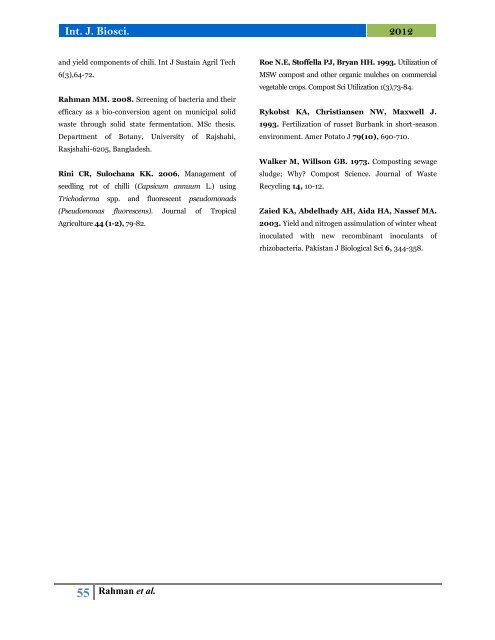Effect of bio compost, cow dung compost and NPK fertilizers on growth, yield and yield components of chili
Abstract To investigate the effects of bio compost, cow dung compost and NPK fertilizers on growth, yield and yield components of chili the experiment was conducted randomized block design with three replications at Botanical Garden of Rajshahi University Campus, Bangladesh during August 2008 to February 2009. There were 15 treatments viz. T1 = bio compost (3 kg/pot) + NPK, T2 = bio compost (2 kg/pot) + NPK, T3 = bio compost (1.5 kg/pot) + NPK, T4 = bio compost (3 kg/pot), T5 = bio compost (2 kg/pot), T6 = bio compost (1.5 kg/pot), T7 = cow dung compost 3 kg/pot + NPK, T8 = cow dung compost (2 kg/pot) + NPK, T9 = cow dung compost (1.5 kg/pot) + NPK, T10 = cow dung compost (3 kg/pot), T11 = cow dung compost (2 kg/pot), T12 = cow dung compost (1.5 kg/pot), T13= NPK, T14= bacterial suspension, T15= control (only soil). Bio compost and NPK significantly (p=0.05) influenced the growth and yield of chili. The treatment bio compost (3kg/pot) +NPK (T1) produced the highest germination (%), vigour index, growth and yield of chili and the lowest yield and yield contributing parameters were recorded in control (T15). The correlation matrix showed that yield per plant of chili had significant and positive correlation with plant height (r = 0.929**), leaf number (r = 0.808**), number of primary branch (r = 0.918**), secondary branch (r = 0.985**), root number (r = 0.953**), root length (r = 0.947**), total number of flower at maximum flowering time(r = 0.981**), total number of fruit ( r = 0.966**), fruit length (r = 0.917**), fresh fruit weight ( r = 0.990**), dry fruit weight ( r = 0.800**), number of seed/ fruit (r = 0.861**) and hundred seed weight ( r = 0.954**) and yield was significant and negative correlation (r = -0.906**) with number of days required for first flower initiation. The results suggest that inorganic fertilizers (NPK) with bio compost (3kg/pot) is suitable for better production of chili that may increase soil fertility and this integrated approach could be contributed to improve crop production.
Abstract
To investigate the effects of bio compost, cow dung compost and NPK fertilizers on growth, yield and yield components of chili the experiment was conducted randomized block design with three replications at Botanical Garden of Rajshahi University Campus, Bangladesh during August 2008 to February 2009. There were 15 treatments viz. T1 = bio compost (3 kg/pot) + NPK, T2 = bio compost (2 kg/pot) + NPK, T3 = bio compost (1.5 kg/pot) + NPK, T4 = bio compost (3 kg/pot), T5 = bio compost (2 kg/pot), T6 = bio compost (1.5 kg/pot), T7 = cow dung compost 3 kg/pot + NPK, T8 = cow dung compost (2 kg/pot) + NPK, T9 = cow dung compost (1.5 kg/pot) + NPK, T10 = cow dung compost (3 kg/pot), T11 = cow dung compost (2 kg/pot), T12 = cow dung compost (1.5 kg/pot), T13= NPK, T14= bacterial suspension, T15= control (only soil). Bio compost and NPK significantly (p=0.05) influenced the growth and yield of chili. The treatment bio compost (3kg/pot) +NPK (T1) produced the highest germination (%), vigour index, growth and yield of chili and the lowest yield and yield contributing parameters were recorded in control (T15). The correlation matrix showed that yield per plant of chili had significant and positive correlation with plant height (r = 0.929**), leaf number (r = 0.808**), number of primary branch (r = 0.918**), secondary branch (r = 0.985**), root number (r = 0.953**), root length (r = 0.947**), total number of flower at maximum flowering time(r = 0.981**), total number of fruit ( r = 0.966**), fruit length (r = 0.917**), fresh fruit weight ( r = 0.990**), dry fruit weight ( r = 0.800**), number of seed/ fruit (r = 0.861**) and hundred seed weight ( r = 0.954**) and yield was significant and negative correlation (r = -0.906**) with number of days required for first flower initiation. The results suggest that inorganic fertilizers (NPK) with bio compost (3kg/pot) is suitable for better production of chili that may increase soil fertility and this integrated approach could be contributed to improve crop production.
You also want an ePaper? Increase the reach of your titles
YUMPU automatically turns print PDFs into web optimized ePapers that Google loves.
Int. J. Biosci. 2012<br />
<str<strong>on</strong>g>and</str<strong>on</strong>g> <strong>yield</strong> comp<strong>on</strong>ents <str<strong>on</strong>g>of</str<strong>on</strong>g> <strong>chili</strong>. Int J Sustain Agril Tech<br />
6(3),64-72.<br />
Rahman MM. 2008. Screening <str<strong>on</strong>g>of</str<strong>on</strong>g> bacteria <str<strong>on</strong>g>and</str<strong>on</strong>g> their<br />
efficacy as a <str<strong>on</strong>g>bio</str<strong>on</strong>g>-c<strong>on</strong>versi<strong>on</strong> agent <strong>on</strong> municipal solid<br />
waste through solid state fermentati<strong>on</strong>. MSc thesis.<br />
Department <str<strong>on</strong>g>of</str<strong>on</strong>g> Botany, University <str<strong>on</strong>g>of</str<strong>on</strong>g> Rajshahi,<br />
Rasjshahi-6205, Bangladesh.<br />
Rini CR, Sulochana KK. 2006. Management <str<strong>on</strong>g>of</str<strong>on</strong>g><br />
seedling rot <str<strong>on</strong>g>of</str<strong>on</strong>g> chilli (Capsicum annuum L.) using<br />
Trichoderma spp. <str<strong>on</strong>g>and</str<strong>on</strong>g> fluorescent pseudom<strong>on</strong>ads<br />
(Pseudom<strong>on</strong>as fluorescens). Journal <str<strong>on</strong>g>of</str<strong>on</strong>g> Tropical<br />
Agriculture 44 (1-2), 79-82.<br />
Roe N.E, St<str<strong>on</strong>g>of</str<strong>on</strong>g>fella PJ, Bryan HH. 1993. Utilizati<strong>on</strong> <str<strong>on</strong>g>of</str<strong>on</strong>g><br />
MSW <str<strong>on</strong>g>compost</str<strong>on</strong>g> <str<strong>on</strong>g>and</str<strong>on</strong>g> other organic mulches <strong>on</strong> commercial<br />
vegetable crops. Compost Sci Utilizati<strong>on</strong> 1(3),73-84.<br />
Rykobst KA, Christiansen NW, Maxwell J.<br />
1993. Fertilizati<strong>on</strong> <str<strong>on</strong>g>of</str<strong>on</strong>g> russet Burbank in short-seas<strong>on</strong><br />
envir<strong>on</strong>ment. Amer Potato J 79(10), 690-710.<br />
Walker M, Wills<strong>on</strong> GB. 1973. Composting sewage<br />
sludge; Why? Compost Science. Journal <str<strong>on</strong>g>of</str<strong>on</strong>g> Waste<br />
Recycling 14, 10-12.<br />
Zaied KA, Abdelhady AH, Aida HA, Nassef MA.<br />
2003. Yield <str<strong>on</strong>g>and</str<strong>on</strong>g> nitrogen assimulati<strong>on</strong> <str<strong>on</strong>g>of</str<strong>on</strong>g> winter wheat<br />
inoculated with new recombinant inoculants <str<strong>on</strong>g>of</str<strong>on</strong>g><br />
rhizobacteria. Pakistan J Biological Sci 6, 344-358.<br />
55<br />
Rahman et al.





![Review on: impact of seed rates and method of sowing on yield and yield related traits of Teff [Eragrostis teff (Zucc.) Trotter] | IJAAR @yumpu](https://documents.yumpu.com/000/066/025/853/c0a2f1eefa2ed71422e741fbc2b37a5fd6200cb1/6b7767675149533469736965546e4c6a4e57325054773d3d/4f6e6531383245617a537a49397878747846574858513d3d.jpg?AWSAccessKeyId=AKIAICNEWSPSEKTJ5M3Q&Expires=1716699600&Signature=VNnwqas2JO%2Bn09W6BgjQM9%2BMsmY%3D)












